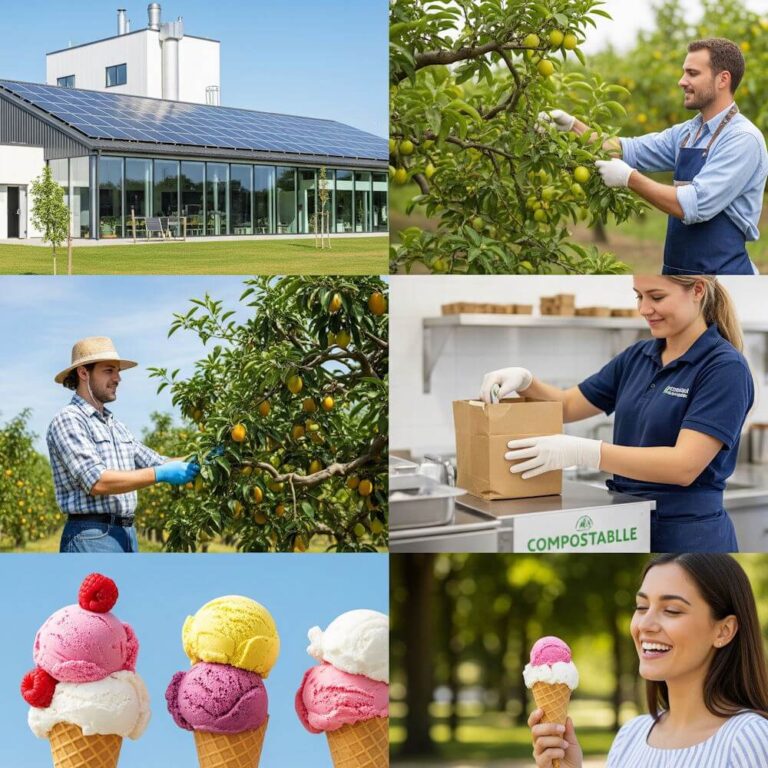The intersection of ice cream production and local farming represents a unique opportunity to foster community connections and support sustainability initiatives. As the popularity of artisanal ice cream continues to rise, many business owners are increasingly recognizing the significance of sourcing ingredients locally. This approach not only enhances the quality of the final product but also establishes meaningful relationships with local farmers, contributing to the agricultural economy.
By prioritizing local agricultural produce, ice cream businesses can create flavors that reflect the regional palette, utilizing fruits, dairy, and other ingredients that are in season. Such sourcing leads to a fresher, more vibrant product, as ingredients are harvested at peak ripeness and delivered soon after, reducing the time from farm to freezer. This commitment to local sourcing not only elevates the ice cream’s taste but also allows consumers to enjoy a product imbued with the essence of their region.
Moreover, supporting local farmers strengthens the community in several ways. For one, it fosters a sense of pride among residents, as they see their local economy thriving and their farmers being recognized for their hard work. Additionally, by engaging with farmers, ice cream businesses can help ensure sustainable agricultural practices. This collaboration often leads to improved biodiversity and reduced environmental impact, aligning with the growing consumer demand for environmentally responsible products.
Ultimately, the marriage of ice cream and local farming is a compelling narrative that resonates with both business owners and consumers alike. As ice cream businesses increasingly focus on local sourcing, they not only enhance the quality of their offerings but also play a vital role in promoting sustainability and community engagement, creating a sweet connection that benefits all involved.
Why Supporting Local Farmers Matters
Supporting local farmers is essential for fostering sustainable economic growth and environmental stewardship within communities. By sourcing ingredients locally, ice cream businesses contribute to a robust local economy. When local farmers thrive through direct sales, they reinvest in their communities, which leads to job creation and more vibrant local markets. This economic support helps to create a cycle of prosperity, where the benefits flow back to the community, ensuring that the wealth generated remains within the locality.
In addition to bolstering the local economy, sourcing ingredients from nearby farmers significantly reduces the carbon footprint associated with long-distance transportation. When vegetables, fruits, and dairy products are shipped over lesser distances, the emissions related to transportation are minimized, leading to a more sustainable food system. This local sourcing not only benefits the environment but also aligns well with the growing consumer preference for eco-friendly practices. Shoppers increasingly favor businesses that prioritize sustainability, and by choosing local producers, ice cream shops can enhance their appeal to environmentally conscious customers.
Furthermore, local farmers often provide fresher and higher-quality ingredients compared to those that are mass-produced and shipped over long distances. Freshness is a critical factor in the production of ice cream, where the quality of the ingredients significantly impacts the flavor and overall product. By partnering with these producers, ice cream businesses can ensure that their offerings are not only delicious but also crafted from the finest locally-sourced ingredients. This commitment to quality helps build trust and loyalty among customers, fostering lasting relationships within the community.
Building Relationships with Local Farmers
Establishing strong relationships with local farmers is a crucial aspect of running a successful ice cream business that emphasizes fresh, high-quality ingredients. The first step in forging these relationships is effective networking. Ice cream businesses can participate in community events, local food festivals, and farmers’ markets, where they can meet farmers face-to-face. By being present at these gatherings, ice cream entrepreneurs are able to create personal connections, which fosters an environment of trust and cooperation.
Engaging directly with farmers not only allows ice cream businesses to learn about the produce they offer but also provides insight into seasonal variations that can influence product offerings. Knowing the timeline of local harvests enables ice cream makers to plan their menus effectively, showcasing seasonal fruits or ingredients through special flavors. Collaboration is key; by working together, both parties can benefit from shared resources and income opportunities. For example, an ice cream business could collaborate with a farmer to develop a unique flavor that highlights their fresh produce, thus providing marketing advantages for both parties.
Another significant element in building lasting relationships is communication. Open dialogue with farmers regarding growth challenges or changes in availability is essential. An ice cream business should express gratitude for the farmers’ efforts while also being honest about fluctuating demand, which can help in adjusting supply agreements accordingly. Trust is built through consistency, reliability, and respect. Regular check-ins, prompt payments, and clear expectations will solidify these partnerships. By nurturing these connections and focusing on mutual support, ice cream businesses can thrive while upholding their commitment to local agriculture.
Creating Unique Flavors with Local Ingredients
The incorporation of local ingredients in an ice cream business offers the opportunity to create distinctive flavors that reflect the regional identity and agricultural bounty. By sourcing fruits, dairy, and other products from nearby farms, ice cream makers can harness the freshness and taste that only local produce can provide. This not only elevates the quality of the ice cream but also aligns the business with a commitment to sustainability and community support.
For example, farmers’ markets often provide a rich array of seasonal fruits that can be transformed into unique ice cream flavors. Consider pairing local strawberries with a hint of basil or crafting a peach and lavender swirl using fruit from local orchards. These combinations are not only intriguing but allow for experimentation with flavors that are often overlooked in mass-produced ice cream. Moreover, using ingredients that are in season ensures that the ice cream remains at its freshest and most flavorful, maximizing customer enjoyment.
In addition to fruits, local dairy provides a creamy and rich base essential for high-quality ice cream. Collaborating with local dairies allows businesses to contribute to the economy while ensuring that the ice cream has an authentic taste. For instance, using grass-fed cream from a nearby farm can create a subtly richer flavor profile, enhancing various ice cream offerings, such as classic vanilla or chocolate. Furthermore, incorporating local spices or herbs can add an exciting twist, as seen in flavors like honey-rosemary or cinnamon-ginger, encouraging customers to try something new.
Ultimately, the use of local ingredients fosters not just delicious ice cream but also a meaningful link between the producers of the ingredients and the consumers. Ice cream businesses that embrace this ethos can celebrate the diversity of flavor while showcasing the talents of local farmers and artisans. The result is a delightful experience for consumers and a vibrant community-centric approach that can set an ice cream business apart in a competitive market.
Marketing Your Local Sourcing Efforts
In today’s competitive ice cream market, effectively marketing your commitment to local sourcing is essential to attract consumers who value quality, sustainability, and community support. One effective strategy is to communicate the benefits of locally sourced ingredients clearly and consistently. Highlighting the superior freshness and superior flavor of local produce can resonate deeply with customers. Customers are increasingly inclined to choose products that not only taste better but also reduce the carbon footprint associated with long-distance transportation.
Utilizing social media platforms presents a substantial opportunity to engage your audience and showcase your partnerships with local farmers. Regularly posting behind-the-scenes content, such as visits to farms or interviews with farmers, can create a unique story that connects your brand with the local agriculture community. In doing so, you can highlight the traceability of ingredients and the personal relationships that underpin your sourcing efforts. This transparency can enhance customer trust and loyalty, as they see firsthand the commitment to supporting the local economy.
Moreover, consider creating content that educates your audience about the significance of local sourcing. Blog posts, videos, or infographics detailing how local sourcing impacts both the environment and the local economy can further solidify your message. Engaging stories about the farmers you partner with — their practices, dedication, and contributions to the community — can also serve to enrich your brand narrative. Emphasizing these aspects will help customers relate to your brand on a personal level, cultivating a sense of community and shared values.
Effective marketing of your ice cream business’s local sourcing initiatives is not solely about promotion but building connections. By integrating these strategies, you enhance not only consumer awareness but also support for local agriculture.
Sustainability Practices in Local Ice Cream Production
The local ice cream industry is increasingly embracing sustainability practices that not only support local farmers but also align with broader environmental goals. By integrating eco-friendly packaging solutions, ice cream producers can significantly reduce their ecological footprint. Biodegradable or compostable packaging materials have emerged as viable alternatives to traditional plastic containers. These sustainable options help in minimizing waste, ensuring that the beautiful surroundings from which local ingredients are sourced remain unspoiled.
Beyond packaging, many ice cream businesses are focusing on waste reduction through various initiatives. This includes adopting practices such as reusing and repurposing materials within their production processes. For example, leftover ingredients and by-products can be transformed into new flavors or used in different desserts, thereby reducing food waste. Furthermore, a commitment to small batch production allows ice cream makers to better control inventory, decreasing the likelihood of surplus stock that may go to waste.
Energy efficiency also plays a crucial role in the sustainability practices adopted by local ice cream producers. Many businesses are investing in energy-efficient machinery and production techniques that require less energy and water. These measures not only lower operational costs but also contribute to a reduction in greenhouse gas emissions. Additionally, utilizing renewable energy sources, such as solar or wind, can further enhance the sustainability profile of local ice cream production.
The combination of these sustainability practices underscores the importance of supporting local farmers and promoting ethical consumption within the ice cream industry. By prioritizing eco-friendly packaging, minimizing waste, and implementing energy-efficient methods, local ice cream businesses can foster a positive impact on both the community and the environment. This holistic approach not only enhances the flavor experience for consumers but also reinforces the interconnectedness of agriculture, sustainability, and delicious ice cream.
Community Engagement and Events
Engaging with the community is a critical aspect of establishing strong relationships between local farmers, ice cream businesses, and customers. By organizing events that bring people together, businesses can foster a sense of community while simultaneously supporting local agriculture. Ice cream socials, for example, provide a delightful environment for families and friends to gather, offering an enjoyable platform to showcase the connection between ice cream and the farming community. During such events, ice cream businesses can highlight the ingredients sourced from local farms, educating attendees about the importance of sustainable practices and the benefits of purchasing locally grown products.
Another effective avenue for community engagement is hosting farm tours. These tours can invite customers to see first-hand the farms that supply their favorite ingredients, offering a tangible connection between the food they consume and its origin. By collaborating with local farmers, businesses can curate informative experiences that showcase agricultural practices, promote understanding of seasonal produce, and highlight the efforts made by farmers to cultivate high-quality ingredients. This engagement not only enhances the visibility of local farming but also encourages consumers to develop a deeper appreciation for farm-fresh products.
Workshops can also play a significant role in community engagement efforts. By facilitating educational workshops that focus on topics such as ice cream-making techniques using local ingredients or the importance of supporting sustainable agriculture, businesses can create learning experiences that resonate with participants. These events strengthen ties between local farmers and the community by providing invaluable insights into the farming process, promoting a farm-to-table ethos. By actively integrating local farmers into these engagements, ice cream businesses can cultivate a loyal customer base that values community support while enjoying delicious, high-quality products. Overall, community engagement initiatives are essential in bridging the gap between local agriculture and the ice cream industry, reinforcing the importance of sustainable practices in all aspects of food consumption.
Challenges and Solutions in Local Sourcing
Local sourcing is often considered a hallmark of quality and sustainability in the ice cream business. However, it comes with its own set of challenges, primarily related to seasonal availability, supply chain logistics, and maintaining consistent product quality. As ice cream businesses strive to support local farmers, they must navigate these complications effectively to fulfill customer demand while adhering to their core values.
One of the primary challenges ice cream entrepreneurs face is the seasonality of ingredients. Many fruits and dairy products are only available during certain months, making it difficult to maintain a diverse flavor range year-round. To address this, businesses can establish partnerships with local farms that offer a variety of seasonal crops and products. This collaboration can facilitate crop planning and promote a “Farm-to-Scoop” cycle where unique flavors are created around what is currently available. Additionally, preserving fruits through canning, freezing, or creating purees can extend the availability of these ingredients, ensuring that unique local flavors are incorporated into the ice cream throughout the year.
Supply chain logistics also pose significant hurdles in procuring local ingredients. The unpredictable nature of agricultural production, weather influences, and transportation issues can lead to supply gaps. To mitigate these risks, ice cream businesses should create robust supplier relationships by establishing contracts with local farmers, ensuring reliability and consistency in ingredient supply. Furthermore, diversifying sources—working with multiple farms for key ingredients—can provide a safety net, decreasing the likelihood of stock shortages.
In conclusion, while sourcing locally presents unique challenges, proactive planning, strong relationships with farmers, and strategic ingredient management can help ice cream businesses navigate these obstacles successfully. By adopting these strategies, businesses can maintain their commitment to local sourcing while offering a delightful range of ice cream flavors to their customers.
Conclusion: A Brighter Future for Local Farms and Ice Cream Businesses
As we have explored throughout this blog post, the symbiotic relationship between ice cream businesses and local farmers plays a crucial role in fostering sustainability and promoting community well-being. By prioritizing local sourcing of ingredients, ice cream makers not only enhance the flavor profile of their products but also contribute significantly to the local economy. Supporting local farmers helps to ensure that the agricultural practices are sustainable, leveraging fresh and seasonal produce which ultimately elevates the quality of the ice cream being served.
The benefits of collaborating with local farms extend beyond just economic factors; they encompass environmental stewardship as well. By reducing the carbon footprint associated with long-distance food transportation, ice cream businesses can partake in eco-friendly practices that help mitigate climate change. Furthermore, by using local ingredients, businesses can support biodiversity and promote the growth of regional ecosystems, ensuring that the land remains productive for future generations.
Communities also stand to gain immensely from the partnership between ice cream makers and local farmers. Local sourcing fosters a sense of community, where consumers feel more connected to their food sources. This connection encourages a culture of transparency and trust, enhancing the relationships between producers and consumers. Ultimately, this engagement can lead to increased patronage of local ice cream shops and further investment in the surrounding agricultural landscape.
In conclusion, by committing to support local farmers, ice cream businesses are paving the way for a brighter future, not only for themselves but for their communities and the environment at large. This collaboration ensures that artisanal ice cream remains a delightful experience while simultaneously fostering a robust agricultural sector. It is a call to action for ice cream entrepreneurs to embrace local sourcing, solidifying their role as champions of local agriculture and sustainability.





